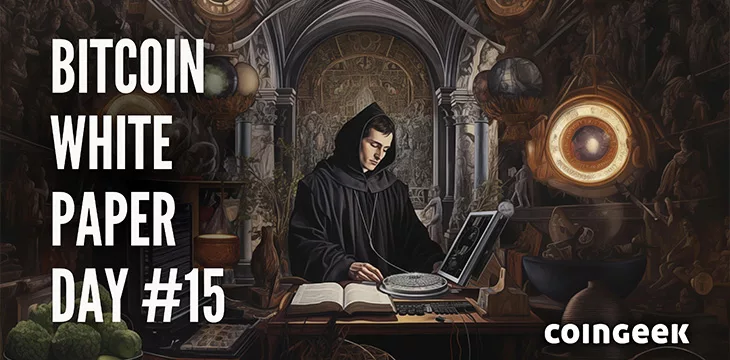|
Getting your Trinity Audio player ready...
|
On October 31, 2008, the global economy felt the first ripples of a seismic shift. The world was suddenly in flux as financial titans’ knees were beginning to rattle. Lehman Brothers had recently failed, and a newcomer named Satoshi Nakamoto declared, “I’ve been working on a new electronic cash system,” in an email to the Cryptography Mailing List. This signaled the end of an era stretching into prehistory where banks and governments held an exclusive monopoly on money issuance. Fast forward to 2023, and it’s been 15 years since the inception of Bitcoin—a milestone worth pondering.
Today marks 15 years since Satoshi Nakamoto unveiled the blueprint for a new peer-to-peer electronic cash system. Marking the landmark moment for an explosion of new applications and solutions, only possible with #Bitcoin. Let's look at some of the other key dates since 2008🤓 pic.twitter.com/yHwa5hhJfp
— CoinGeek (@RealCoinGeek) October 31, 2023
The number 15 holds various numerological significances. It is often considered the number of “change” aligned with divine grace, rest, and mercy. In Hebrew, the numbers “10” and “5” come together to form the word “Yah” (יה), which is a common Hebrew name for the Creator of the universe. In fact, it is this name “YHWH” (יהוה) which implies something like “the breaths of the Creator who spoke the world into existence.” Christians may recognize this as “Yahweh” Or “Jehovah.” This name for the Creator also appears in the common word of praise: “Hallelujah!“
Hebrew scholars will criticize my reductionism here (and I will encourage you to spend some time studying the Hebrew language and numerology so you can criticize me too,) but the name contains the jots and tittles that signify breathe itself, and it’s those heavily breathed words which “let there be light” to all of reality. So, in short, it can be said that the number 15 and its breath is actually the formula for creation itself.
Considering the seismic shifts that Bitcoin has triggered in our economic systems and the probability that the Bitcoin white paper was written through spoken word dictation, the divine grace of 15 years feels especially poignant.
Small blockers’ wet blanket
To douse the magic of the Creator, James Donald was the first person to respond to Nakamoto on Halloween 2008, and his response came with a skepticism now symbolizing an enduring clash between different visions for Bitcoin. Donald expressed concern about scalability, arguing that every user needed to run a full node for the network to function. Satoshi, however, saw a future less confined to such limitations and laughed off the first small blocker. Fifteen years later, the debate rages on, with innovations and divisions coloring the landscape of blockchain assets.
October 31: A day of reformation
October 31 holds a rich tapestry of cultural and historical significance. The ancient Gaelic festival Samhain, All Hallow’s Eve, All Saints Day, and Martin Luther’s Ninety-Five Theses in 1517 all share this date. Each revolutionized human thought in their own right—from the convergence of old-world and new-world spiritual beliefs to the decentralization of church governance. Satoshi likely chose October 31 for its symbolic value, aligning Bitcoin with a long history of paradigm shifts.
Centralization to Decentralization: Bitcoin’s promise
When Bitcoin’s white paper was released, it proposed a peer-to-peer system for “Commerce on the Internet.” Its distributed and competitive structure promised to lower transaction costs, making micropayments not just feasible but efficient. The launch in January 2009 saw the genesis block contain extra text data stating “Chancellor on the brink of second bailout for banks,” emphasizing the need for a more equitable system or maybe just the value of time-stamped data on a public ledger—depending on who you ask.
Just as All Saints’ Eve combined elements from Christian and pagan traditions to become Halloween, Bitcoin absorbs and amplifies best practices from the financial systems that preceded it—mixing the best powers of gold and cash with the magic of the internet. Yet, it also sidesteps most of their shortcomings, introducing a level of transparency and fairness hitherto unimaginable.
However, so much of Bitcoin’s promise seems far off in the aether in a perpetual place of “someday soon” as the acts of the Bitcoin Civil War trudge forward and the businesses that use Bitcoin fail to be truly sticky in the new economy. May Bitcoin be realized so that our fallen world can be set back in place to continue forward the quest for economic fairness and transparency.
15 years on: The road ahead
As we celebrate this significant 15-year mark, we must remain attuned to the need for continued innovation and vigilance against the forces of obfuscation and centralization. The spirit of October 31—a day of transformation—must continue to inspire the Bitcoin world. After all, 15 years in the world of technology is both an eternity and a fleeting moment.
The challenge now is to keep the essence of Satoshi’s vision intact for the next 15 years and beyond.
Understanding the Bitcoin Whitepaper Section One: The Introduction

 12-27-2025
12-27-2025 




